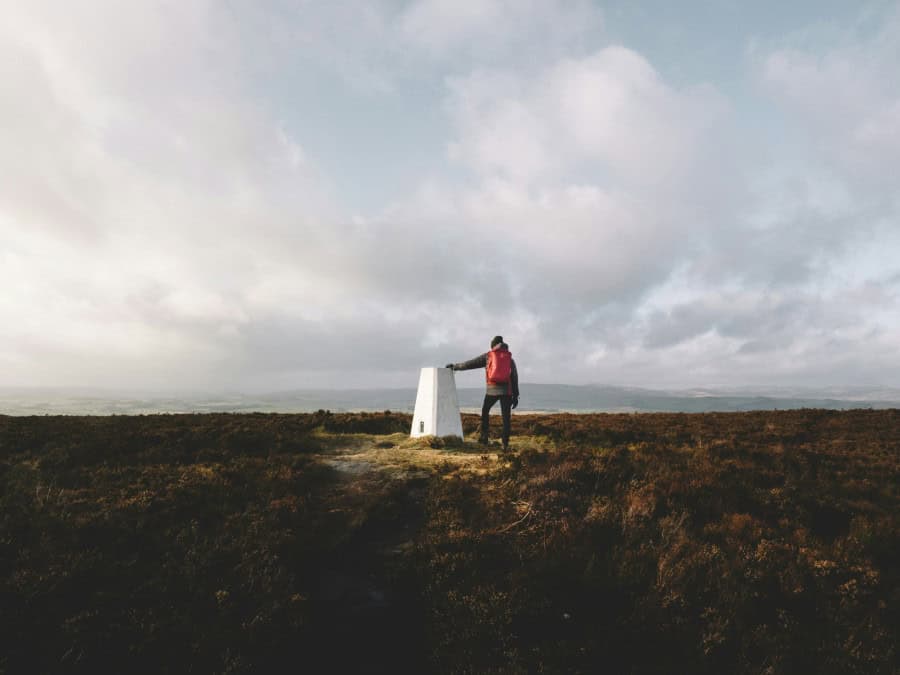Table of Contents
Some links on posts are affiliate links and will earn us a commission from qualifying purchases
There’s a special kind of thrill that only walkers and hikers truly understand — that moment when you spot a weathered concrete pillar on the horizon. It stands proudly atop hills and moorlands, often windswept and lichen-covered, marking a summit or a strategic vantage point. To the uninitiated, it’s just a strange block of concrete. But to many outdoor lovers in the UK, it’s a triangulation point – or “trig point” – and discovering one is like finding a hidden treasure. For some, visiting them has become a delightful obsession.
What Are Triangulation Points?
Triangulation points, commonly called trig points or trig pillars, are concrete pillars erected by the Ordnance Survey as part of a nationwide effort to map the UK with precision. Between 1936 and 1962, over 6,500 of these were constructed as part of the Retriangulation of Great Britain — a monumental surveying effort that would revolutionise mapping accuracy.
Each trig point was precisely positioned and used to take angular measurements to other trig points on the horizon. By measuring these angles and using the mathematical technique of triangulation, surveyors could calculate exact positions and elevations. These pillars were the physical backbone of Britain’s modern map system before satellites took over.
You’ll typically find trig points at high points: on mountain tops, ridges, hills, and sometimes even in fields or forests. While their original purpose may have become obsolete, their legacy lives on in the hearts of walkers who set out to “bag” them.
From Mapping Tools to Modern-Day Challenges
Though these concrete pillars no longer serve a technical purpose, they’ve taken on a new life as cultural and recreational waypoints. Many walkers get a buzz from reaching one — sometimes capping off a tough climb, or just marking progress on a route. Others go further, turning trig point hunting into a hobby in its own right.
One such enthusiast is Rob Woodall, who took his passion to the extreme by visiting every single one of Britain’s 6,190 trig points — a feat that took him 14 years to complete. His journey, chronicled in Dull Men of Great Britain, is both inspiring and quirky — proof that obsession, determination, and a love for the outdoors can lead to remarkable adventures.
Of course, you don’t need to scale every pillar in the land. For a more achievable challenge, many hikers aim to tick off all the trig points in their county, their favourite National Park, or focus on the 314 primary triangulation points — the most significant in the national network.
Why Trig Bagging Has Such Appeal
Part of the charm lies in where these trig points are located. From the rugged ridges of Skiddaw in the Lake District to the rolling chalk of Ditchling Beacon in the South Downs, and the wild peaks of Fan Brycheiniog in the Brecon Beacons to the remote vastness of Dartmoor’s Yes Tor — these pillars are often found in places of breathtaking natural beauty.
Finding them offers a sense of achievement, especially since many require effort to reach. Often, there’s no direct path to a trig point, meaning you’ll need to navigate using a map, compass, or GPS. It’s a chance to brush up on orienteering skills and enjoy off-the-beaten-path exploration.
For those who love a good list and enjoy ticking things off, trig point hunting scratches that itch too. Online communities and apps like TrigpointingUK allow you to track which ones you’ve visited, read other walkers’ logs, and even upload photos. It adds a fun layer of purpose to your walking life.
Getting Started with Trig Point Hunting
If you’re tempted to start bagging trig points, it’s easy to begin. Just pick a familiar area — maybe your home county, a local hill, or a National Park you love — and see where the trig points lie. Ordnance Survey maps mark them with a small triangle and a dot at the centre.
Start slow. Enjoy the views. Take a photo at the top. Some trig pillars are now on private land, so always check access rights and stick to public footpaths where possible.
Conclusion: More Than Just Concrete Pillars
In the end, trig points are far more than relics of surveying history. They represent a meeting point between exploration, personal challenge, and quiet moments in the wild. Whether you’re scaling a well-known summit or wandering through forgotten fields, spotting a trig pillar always adds a spark of joy to your journey.
So next time you’re out walking and see one in the distance, take a detour. Climb the hill, touch the concrete, and maybe — just maybe — let yourself catch the trig bagging bug.
Recent Posts
If you are staying in Eastbourne then it is worth getting out and exploring the beautiful countryside. But you can also explore the town itself, and especially enjoy a coastline walk. I popped to...
We first visited the beautiful village of Firle in Sussex in June 2017. Nicky had booked a night away at an Airbnb property in the village as a surprise for my birthday. She is an avid fan of the...


